HomeArticles
They ASKED for it! A severe test of Leapers' new extra-rugged scopes
They asked for it! Leapers scopes (July 2005)
By Tom Gaylord
exclusively for PyramydAir.com. © Copyright 2005 All Rights Reserved
Rifle scopes are not always as tough and rugged as airgunners need them to be. A question that arises whenever we consider a new scope is, "Can it handle the recoil of my rifle?" Until now, that question has been answered only through experience - sometimes good and other times not. After trying close to 100 different scopes on several hundred different air rifles over the past 10 years, I've learned to hold my opinion of a new scope until it proves itself.
When Leapers asked me to test an early production sample from their latest TS scope line, they told me they have engineered them to be extra-tolerant of recoil. The tests they put the new scopes through are the same qualifying tests the American military has used for decades to test ruggedized mil-spec equipment.
The scope I tested is a 3 to 9 power variable with an illuminated reticle and a 40 mm objective lens. The reticle is a combination of duplex and mil dot, which is unique, I believe.
Leapers offers both hunting and tactical scopes under the TS banner, which stands for True Strength. What they have done is strengthen the interface between the outer scope tube and the inner erector tube that contains the reticle. This not only gives them unparalleled strength, but more positive control over windage and elevation adjustments.
LEAPERS MIL SPEC TESTS
There are two tests for ruggedness. One is a drop-hammer test in which a weight of a specified size is dropped from a specified height to impact the test stand on which the equipment is mounted. The hammer weighs 11 lbs. and swings through an arc from a one-meter height. That may not sound like much, but the impact has been known to shear thick mounting bolts and send equipment flying. This test proves the scope can take recoil.
Leapers used the hammer in both directions to test for recoil tolerance both ways. Unlike firearms, which kick on to the rear, a spring-piston air rifle kicks both ways, but much harder in the forward direction. This two-way snap has proven brutal on scopes. Firearms scopes that could ride out a .30-06 with no problem have been reduced to a handful of parts by a magnum air rifle.
The second test is a vibration test. The scope is mounted to a vibrating table for a period of time to simulate the collective buildup of vibration from thousands of shots. Some air rifles vibrate their scopes apart in no time, so this test discovers whether a scope can take it.
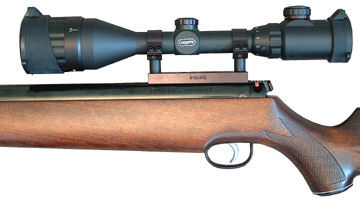
Leapers' new rugged scope has lots of features in an attractive package. |
The new scope looks no different on the outside than a lot of others. Only the round switch to control the dual red-green reticle illumination gives anything away.
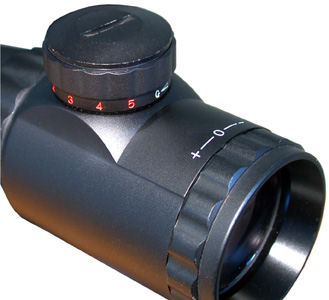
The switch above the eyepiece controls five intensity levels of light for both the red and green reticle. |
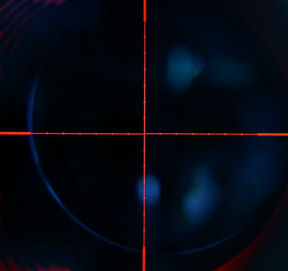
The red reticle shows the same image as the normal black crosshairs - a combination mil-dot and duplex. Green color is also available in the same switch. Reticle is etched into glass so there is no flare-up from the light. |
Looking through the scope reveals a reticle that is unique, as I mentioned before. It's BOTH a duplex AND a mil-dot, plus the light switch can illuminate the reticle with five levels of red OR green light to help you see the crosshairs in low-light situations! That is a lot to pack into one scope, and I don't think anyone else does it. This is a hunter's scope!
CAN THEY TAKE IT?
But these features are not the big story. Leapers says this new scope can take any punishment a magnum recoiling air rifle can dish out. That sounded too much like a challenge to ignore, so I called them on it.
They sent me an early production sample and asked me to give it a good test. The hardest-recoiling airgun in the business is Webley's Patriot, or what Beeman calls the Kodiak. It can bruise the shoulder of a careless shooter in just a handful of shots, or give you a headache, if you hold it too tightly while shooting.
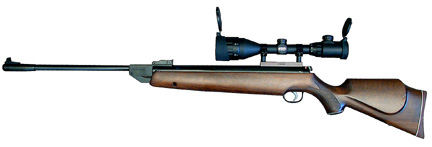
The Patriot is a large rifle that accepts the Leapers scope well. Scope rests in a B-Square AA adjustable high mount. Sunshades are shown in raised position. |
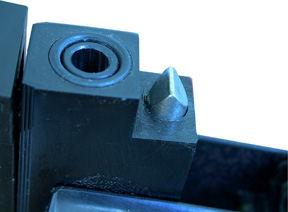
It takes a lot to keep the barrel closed when the Patriot fires. This chisel detent is so powerful that a special technique is needed to open the barrel. |
THE RIFLE
The Patriot is a 9-lb. breakbarrel spring rifle that generates as much as 30 foot-pounds when shooting the heaviest pellets. Pyramyd Air supplied one in .25 caliber, which is a great choice for hunters. This is the only really affordable springer in this power range.
Cocking a Patriot means slapping the muzzle to pop open the spring-loaded breech detent. Most men cannot open the barrel with just the strength of their arms, and more than a few cannot cock it at all. The detent keeps the breech closed during firing against hundreds of pounds of air pressure. Slapping the muzzle is the only way to break open the barrel, and the owner's manual tells you to do it!
THE MOUNT
B-Square makes a scope mount that fits the Patriot/Kodiak scope stops perfectly. Because the Patriot is such a kicker, Webley & Scott have machined several notches into the scope mounting spot on top of the receiver. A scope mount needs half-round pins to mate with these notches. Once mated and tightened down, nothing is going to move the mount on the gun.
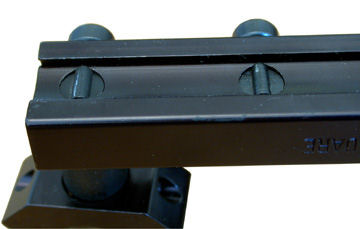
Two half-round pins on the bottom of B-Square's mount interface with grooves in rifle's receiver. Rifle's recoil requires both pins to be used! |
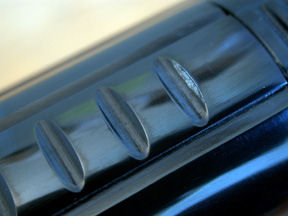
The top of the Patriot receiver has grooves to accept scope mount pins for a positive lock. |
The mount used in this test is B-Square's AA adjustable high one-piece mount. This was a chance to prove, once and for all, that an adjustable mount is just as rugged as a fixed mount, while allowing the scope to be adjusted without putting any strain on the scope tube.
THE FIRST TEST!
I decided that for this to be a conclusive test, the scope had to ride out a long string of abusive shots. Although I don't like cocking the Patriot, I settled on 750 shots as the number. Anyone who ever shot a Patriot can tell you that 750 shots constitutes a LOT of abuse for any scope.
I shot 100 times per session, because that was all my arms could take. The cocking effort is 50 lbs. and, though it does become smoother as the rifle breaks in, it never gets lighter.
I made no attempt to sight the gun for the first test. The scope was just mounted tight to take the recoil. The pellet trap was positioned about eight feet away with a thick sheet of cardboard over the opening to keep the backsplash down.
ALL SHOOK UP!
Once the shooting began, things started to happen! The scope mounts had to be tightened several times. The screws were coated with Locktite, but it made no difference. Also, the rubber eyeshields that house the flip-up scope caps fell off during every session until I finally removed them.
The Patriot's rear sight fell off after 300 shots. I should have checked the mounting screws more often. After I re-mounted the sight and tightened the screws, it never loosened again.
The stock screws became very loose in the first 100 shots, but I snugged them back down and they stayed tight for the rest of the test. Loose screws on a rifle like this can lead to a split stock, so you have to pay attention.
After every 100 shots, I looked through the scope to be sure the optics had not gotten loose or shifted in some way. The reticle is etched on a glass plate, so there is nothing to break, but I was concerned that the central erector tube stayed where it was supposed to be. This is the area Leapers strengthened, and it never moved through the entire test.
THE RESULTS OF THE FIRST TEST
The scope passed the first test with flying colors. Nothing inside moved or became loose in the slightest. Other brands of scopes have failed dramatically after being subjected to far less abuse.
The red/green-illuminated reticle was still working perfectly at the end of the recoil test. All that remained was to determine if the scope's reticle adjustments still worked, and that meant another test.
TEST TWO
The second test determines that the scope still functions as it should. Looking through a scope can tell you if the optics are okay, but you have to try the adjustments to know that they still work. A simple way to do this is to shoot at a target, holding on the same aim point for every shot, and adjusting the reticle around the target. If the pellet moves in the same direction as the adjustment, the scope works.
This test can be refined by making several adjustments in all directions and by shooting the last shot at the same setting as the first. If the rifle is accurate and the scope adjustments work, the last pellet should hit pretty close to the same place the first one went, despite having been adjusted several times.
I sighted the Patriot at 20 yards and shot several groups with different pellets to see which one was best. Beeman Kodiaks were superior to all others by a wide margin. In fact, nothing else was close.
Normally, I hold a recoiling airgun very loosely, allowing it to recoil as much as it wants to. With this particular rifle, that technique didn't work. My groups were large and all over the place, but when I pressed the butt into my shoulder, things tightened up. I didn't have a death-grip on the gun, just firm contact with the butt pad against my shoulder. I still held the pistol grip loosely and laid the air rifle across my open palm.
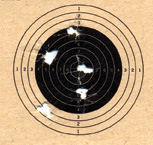
The aim point for every shot was the center of the bullseye. Hole at 7 o'clock position was made by both the first and last shot. Adjustments were positive and reliable. |
I usually try to preserve the aim point when doing this test, so I adjust the strike of the pellet away from the center of the bullseye. The first shot landed at 7 o'clock, just outside the black. Then, I adjusted the scope 15 clicks to the right and 15 clicks up for shot two.
Shot two is in line with the center of the bull but below the dot in the exact center. I didn't plan to get this close to the centerline, but as long as it happened, I adjusted the scope up 10 more clicks and took out the center of the bull with the third shot. Then, 20 more clicks up and I shot again. I had to guess where the center was because my last shot had removed it.
Shot four landed at the top of the black, at what looks like almost 12 o'clock. The scope was then adjusted to the left and down; bringing shot five to the 10 o'clock spot. I then adjusted down to bring the scope back to the starting point and the last shot went through the same hole as the first shot (7 o'clock, just outside the black).
The reticle adjustments were as crisp as those found on a new scope. There was no backlash or hesitation of the shot to move as the scope was adjusted. Some scopes like to have a shot or two fired before they settle down at a new zero point, but not this one! It moves precisely from one adjustment to the next, just like you'd expect.
CONCLUSION
Leapers' TS scope platform is rugged and precise. This test not only proved the toughness of the new platform, it also acquainted me with a desirable blend of features that exist in no other scope. Even if this weren't the toughest kid on the block, it would be worth trying for all the benefits it offers.







